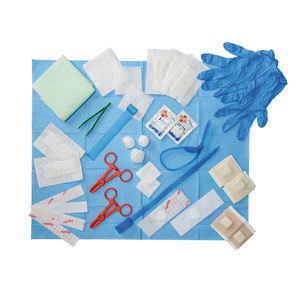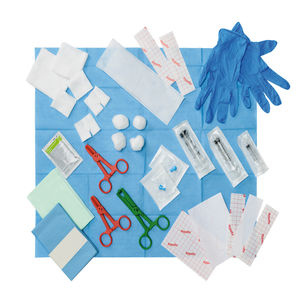

- Company
- Products
- Catalogs
- News & Trends
- Exhibitions
Dialysis medical kit with glovesterilecustomizable
Add to favorites
Compare this product
Characteristics
- Applications
- dialysis
- Other characteristics
- with glove, sterile, customizable
Description
The kit may contain:
Absorbent and waterproof sterile sheet to create a sterile field
Sterile sheet equipped with a cut, hole and an adhesive, to better adapt the use of the device in the dressing procedures of the peritoneal catheter
A pair of sterile gloves, model and size of choice (latex, vinyl, and nitrile)
Sterile gauze pads in cotton or non-woven fabric (TNT)
Y-shaped or straight-cut gauze to create a dressing around the catheter
Masks to avoid contamination
Air-permeable adhesive plasters in non-woven fabric to fix dressing
With peritoneal dialysis, the blood is cleaned up inside the body. Peritoneal dialysis involves the introduction of an exchange fluid into the peritoneal cavity and the use of the peritoneum (thin membrane surrounding the abdominal viscera) as a semipermeable membrane. It is usually performed at the patient’s home. The dialysis solution – water with salt and other additives – flows from a bag through a permanent catheter in the abdomen. After 4-5 hours, the solution and the waste are discharged from the abdomen into the empty bag. A variant of the process is performed at night while the patient is sleeping, using automatic machines. There are two types of peritoneal dialysis: CAPD (continuous outpatient peritoneal dialysis, 3-4 exchanges per day) APD (automated peritoneal dialysis, performed at home at night, with a special machine).
Catalogs
No catalogs are available for this product.
See all of D.R.M.‘s catalogsRelated Searches
- Medical kit
- Surgical mask
- 3-ply surgical mask
- Disposable surgical mask
- EN14683 surgical mask
- Blue surgical mask
- Non-woven surgical mask
- Sterile medical kit
- Type IIR surgical mask
- Tourniquet
- Disposable medical kit
- Latex-free surgical mask
- General care tourniquet
- Medical kit with glove
- Elastic tourniquet
- Clip-type tourniquet
- Customizable medical kit
- Disposable tourniquet
- Dialysis medical kit
*Prices are pre-tax. They exclude delivery charges and customs duties and do not include additional charges for installation or activation options. Prices are indicative only and may vary by country, with changes to the cost of raw materials and exchange rates.


